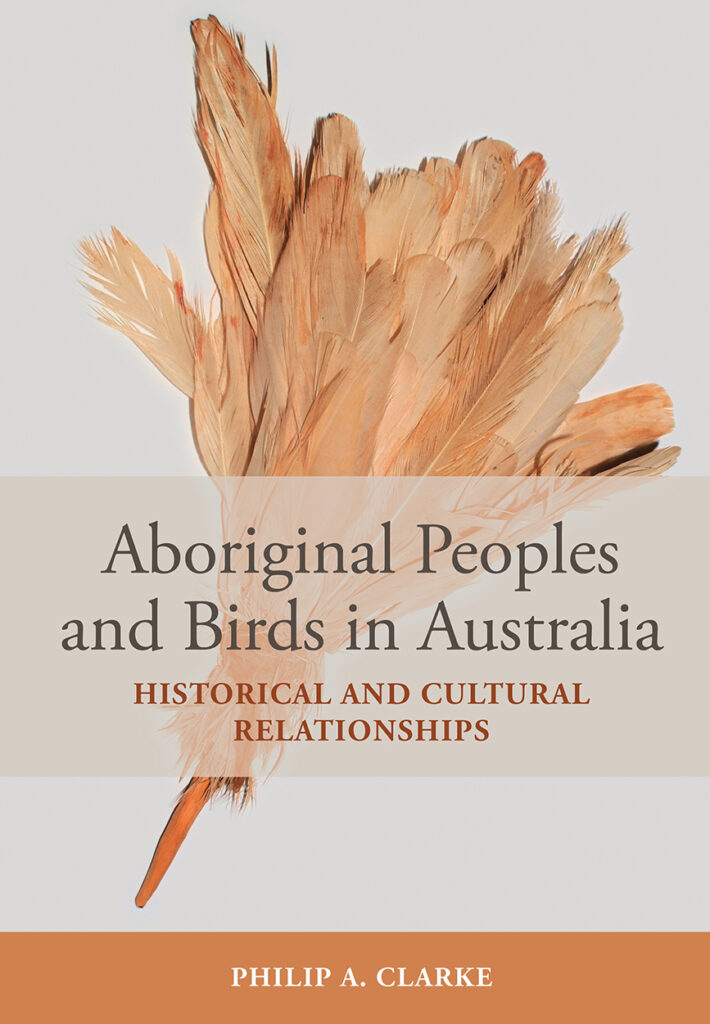https://www.publish.csiro.au/book/8065/ Philip A Clarke. 2023. CSIRO Publishing, Clayton, Victoria, AUS. ISBN 9781486315970. Paperback ($59.99 AUS).
This is a very welcome publication. Anthropologist Philip Clarke has produced a wide-ranging survey of the historical and cultural relationships between Australia’s aboriginal peoples and its distinctive avifauna. These relationships are both deep and complex. When the first European settlers encountered this vast continent they were entering a world whose indigenous inhabitants had over thousands of years evolved a most detailed and intimate knowledge of their natural surroundings and its wildlife. They were, as one later observer expressed it, ‘the most competent naturalists that ever were, or ever will be’. Aboriginal populations were distributed over a huge variety of different environmental zones and habitats from tropical forests to arid deserts and they spoke over 200 different languages, but what was common to all of them was the importance of birds in their lives.
Birds were a key food source for the aborigines, so they became expert foragers, stalkers and hunters, acquiring a detailed familiarity with bird behaviour and their seasonal cycles. In the Lower Murray they harvested the eggs of Mallefowl in September, in the Northern Territories those of the Magpie Goose in February (‘goose-egg time’). They could bring down waterfowl, cockatoos and parrots with their throwing-clubs and boomerangs; and they used a variety of ingenious butterfly and other lures to attract big game like Australian Bustards, Emu and Brolga close enough to spear them. They also used birds as weather forecasters (a calling Channel-billed Cuckoo was a ‘rain-bird’); for bush intelligence (the Pallid Cuckoo call was an alert for a nearby large Goanna); as guides to drinking water in arid regions ( the ‘diamond birds’ like Zebra Finches and Spotted Pardalote); and as material sources of medicines (Emu oil for aches and pains), fans and brushes (Magpie Goose wings), tools (Emu tibia as gouges) and ornaments (Major Mitchell Cockatoo plumes, as featured on the book’s front cover).
No surprise then that birds featured heavily in their myths, folklore and rituals as symbols of the ecology on which they depended for their sustenance and survival – and of which they themselves were an integral part. Clarke gives a very sensitive and respectful account of the various aboriginal world-views (plural, because these were themselves quite diverse), in which birds play central roles. So central, indeed, that human and avian identities often became merged. Birds are regularly conceived as ancestor figures in creation myths, sharing many human characteristics, and their descendants were later divided into people and the different bird species. Among the most prominent mythic birds with these totemic qualities were the Emu, Australian Bustard, Australian Pelican, Brolga, Wedge-tailed Eagle and Raven, and Clarke tells us many of the traditional stories that accreted around these. He also gives extensive examples of the bird names and their classification systems in aboriginal languages, which don’t always map neatly on to those later assigned by European ornithologists. For example, the Emu is classed among ‘edible animals’ rather than birds – perhaps not surprising given its size, flightlessness and untypical plumage – while generic terms may be based on factors like size, shape, habitat and behaviour rather than the kind of evolutionary relationships articulated in Western scientific taxonomies. Most aboriginal languages even seem to lack a concept of Birds exactly equivalent to that of Aves in the Linnaean system.
Clarke is eager to stress in his conclusion that these alternative world-views are complementary to those of Western empirical science. They encode a depth of traditional environmental knowledge that is completely integrated into their cultural practices and can’t be extracted from it in the form of literal ‘facts’. Like other kinds of myths, allegories and metaphors – or indeed poetry and imaginative literature more generally – they are ways of making sense of the world and giving it human significance. We sometimes use the word ‘myth’ in English in a pejorative way to mean ‘false belief’, but the original meaning of the word in Greek just meant ‘story’. Stories may be revealing or otherwise but they are not simply true or false.
This is a very thorough work of scholarship in the relatively new field of ethnoscience, specifically in this case ethno-ornithology. The original sources are of course all oral, while the extensive written sources from the colonial period onwards are themselves interpretations that need further skilled interpretation. This can now happily be supplemented, and where necessary ‘decolonised’, by living indigenous informants. The result is an invaluable work of reference for further research. It is also a timely publication. Many aboriginal languages have become extinct and many more are endangered, with just a handful of ageing active speakers. Meanwhile, the country’s biodiversity is also fast declining. A reminder, then, that cultural and biological diversity are inextricably intertwined.
Jeremy Mynott
Naturalist and Author of Birdscapes: Birds in our Imagination and Experience and Birds in the Ancient World
Header photo: Lamington National Park. Gary Stolz
Suggested citation:
Mynott, J. Review of the book Aboriginal Peoples and Birds in Australia: Historical and Cultural Relationships by Philip A Clarke. Association of Field Ornithologists Book Review. https://afonet.org/2023/09/aboriginal-peoples-and-birds-in-australia/.
If you are interested in contributing a book review, or if there is a book you would like to see reviewed on our site, you can contact our Book Review Editor, Evan Jackson at evan.jackson@maine.edu


One thought on “Aboriginal Peoples and Birds in Australia”
Comments are closed.